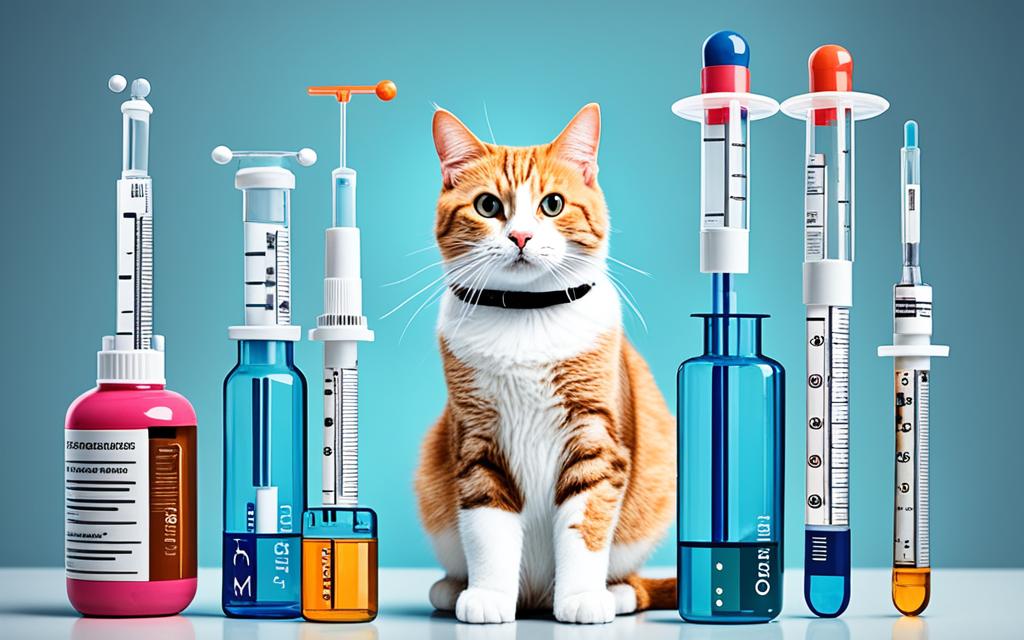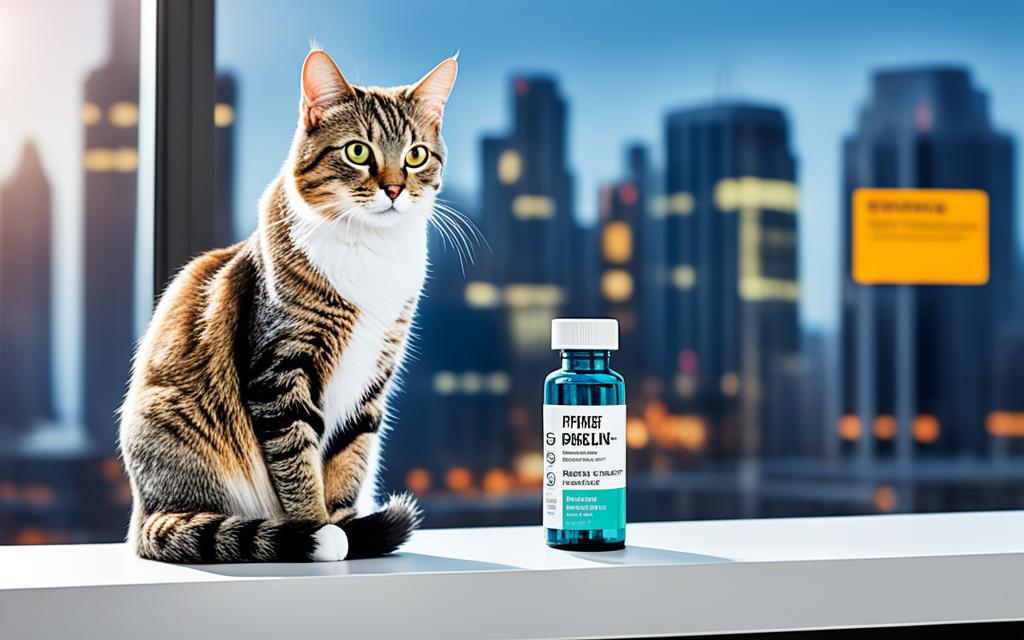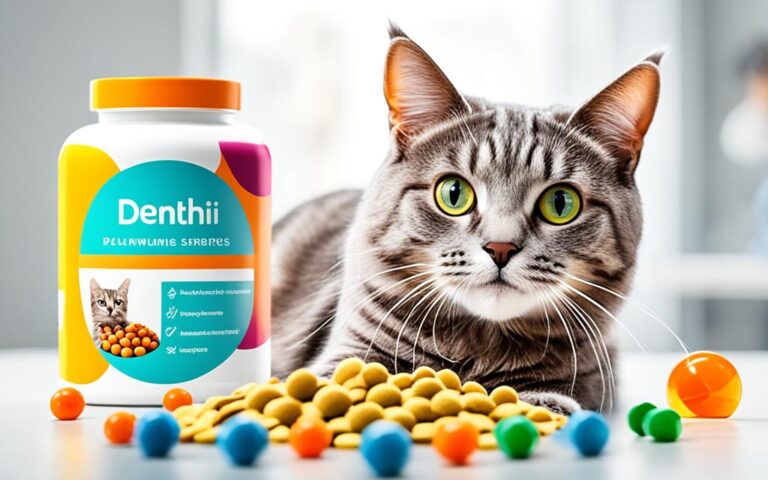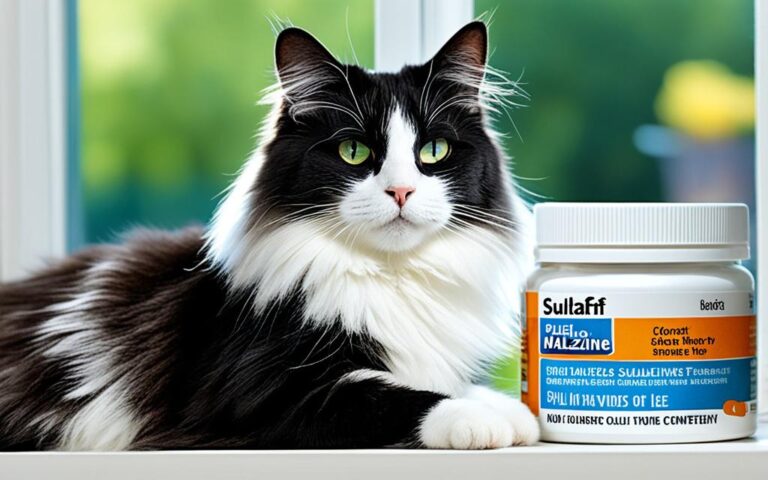Buprenorphine for cats: Uses and Brands
Did you know that buprenorphine is used for both cats and humans1? The FDA has approved it for this purpose. Veterinarians can use it for cats in certain cases1. It’s a kind of opioid that works well for pain, and it’s safe for cats.
Several brands of buprenorphine are out there. These include Buprenex®, Simbadol®, and more2. You can get it in different forms, like shots, pills, or under the tongue. This variety helps vets pick what’s best for each cat2.
Key Takeaways
- Buprenorphine helps with pain and is FDA-ready for cats and people.
- It comes in many forms to make treatment easier.
- It’s good at stopping pain and is safe for cats.
- Vets use it for surgeries and long-term pain care.
- Remember, the right dose and watching the cat is key.
Table of Contents
Introduction to Buprenorphine
Buprenorphine is a strong medicine for pain in cats. It’s from the opioid family, making it very powerful, about 30 times stronger than morphine3. You might know it by names like Buprenex®, Simbadol®, Belbuca®, and Vetergesic®. These various names help meet different needs in the pet healthcare world.
What is Buprenorphine?
This medicine is unique because it doesn’t fully activate a key receptor in the body. By working this way, Buprenorphine offers pain relief with fewer harmful effects than full opioids4. It also binds tightly to proteins in the body, making its pain relief quite strong4.
Brand Names: Buprenex®, Simbadol®, Belbuca®, Vetergesic®
Its many brand names, like Buprenex®, Simbadol®, Belbuca®, and Vetergesic®, show how flexible it is. They meet the unique needs of both veterinarians and doctors, ensuring the best care for patients. This includes different ways to take it, how much to use, and how it’s used, all for the best pain control5.
“Buprenorphine is classified as a Schedule III controlled substance in the United States, indicating its potential for abuse and dependence, although to a lesser extent than Schedule II opioids like morphine.”4
Buprenorphine as an Opioid Analgesic
Buprenorphine is an opioid analgesic that blocks or reduces pain signals sent to the brain6. This helps cats feel calm and rest which aids in their recovery. It’s a preferred choice in veterinary care because it offers strong pain relief with fewer side effects4.
Understanding Opioid Analgesics
Opioids like buprenorphine attach to specific areas in the brain and spinal cord called opioid receptors. By doing this, they stop the pain signals’ journey, which lessens how much pain is felt6. Buprenorphine is around 30 times more potent than morphine in some aspects6.
Benefits of Buprenorphine for Pain Management in Cats
Buprenorphine is great for easing mild to moderate pain in cats6. It’s liked by vets because it’s strong yet safe. Vets often choose it to help feline patients handle pain4. A new option, Zorbium®, offers up to 4 days of pain relief from a single dose6.
In a study, more cats had good pain management for four days after surgery when they got buprenorphine. This shows its value for post-surgical care or for severe pain from injuries7.
“Buprenorphine is valued in veterinary medicine for its ability to provide effective pain relief while having a relatively safe side effect profile, making it a commonly used option for managing pain in feline patients.”
Modes of Administration
Buprenorphine is a strong pain medicine for cats. It can be given in different ways to help with pain. The best way is by letting the cat absorb it through the cheek or under the tongue. This method is called transmucosal route8. It’s less stressful for the cat than other ways9.
Another way to give buprenorphine is through injection. This can be done under the skin, into the muscle, or into a vein8. These methods are mainly used in the hospital or clinic9.
Oral/Transmucosal Routes
Transmucosal administration is top choice for buprenorphine in cats. It involves absorbing the drug through mucus8. This is good because it avoids stress and works fast9.
Injectable Routes
Buprenorphine can also be given by shot. This includes under the skin, in the muscle, or into a vein8. These methods require special knowledge and gear. They’re often used in clinics9. For example, Simbadol is a type of buprenorphine given under the skin. It works for 24 hours8. The usual muscle shot for cats and dogs is 0.02 mg/kg8.

In short, there are many ways to give buprenorphine to cats. The best option is the non-stressful transmucosal way. Other methods like shots are used mainly in clinics8910.
Buprenorphine (Buprenex®, Simbadol®, Zorbium®) for Cats
Buprenorphine is a powerful opioid used to treat pain in cats. Vets often prescribe Buprenex®, Simbadol®, and Zorbium® for our furry friends. These medications are great for easing pain after surgery or for severe pain.
Zorbium® is a special kind of buprenorphine. It’s the first FDA-approved buprenorphine you can put on a cat’s skin. Using Zorbium®, pain gets better in 1 to 2 hours and stays away for up to four days from just one use7.
But, Zorbium® isn’t for use at home. Vets need to apply it to keep it safe for the cat7. Aside from Zorbium®, there’s also Simbadol® and Onsior® for cats7. They give different kinds of pain relief. Simbadol® helps for 24 hours with one shot. Zorbium®, on the other hand, is the first of its kind to use on a cat’s skin7.
| Brand Name | Formulation | Key Features |
|---|---|---|
| Buprenex® | Injectable | Opioid analgesic for pain management in cats |
| Simbadol® | Injectable | Provides 24-hour pain relief with a single dose6 |
| Zorbium® | Transdermal Solution | First FDA-approved transdermal buprenorphine for cats7 Provides pain relief within 1-2 hours, lasts for 4 days7 Applied by trained veterinary professionals to avoid misuse7 |
Buprenorphine is a key medicine for managing pain in animals. Studies show it helps cats feel better after surgery for up to 4 days than those not treated. But, some cats can have side effects like changes in body signs or not feeling well7.
Remember, Zorbium® is a controlled substance with a safety warning7. Elanco US Inc. makes Zorbium® and is in Indiana7.
“Buprenorphine is considered approximately 30 times stronger than morphine in many of its effects.”6
Buprenorphine works well and is safe for cats. It’s a good option for managing their pain. By knowing about different buprenorphine options, vets can choose what’s best for their patients.
Dosing and Frequency
Managing pain in cats involves careful thought about how much buprenorphine they need and how often11. Buprenorphine is a drug that helps cats with pain, from after surgery to chronic issues. A vet looks at the cat’s weight, pain level, and what’s wrong to decide the right dose.
Cats usually get buprenorphine by mouth or through the mucous membranes once or twice a day11. For Simbadol, the recommended dose is 0.24 mg/kg given under the skin every 24 hours11. The even more concentrated Simbadol version is 1.8 mg/mL, compared to the standard 0.3 mg/mL injectable11.
Your vet will give you exact dosing instructions because each cat may need a different amount of buprenorphine12. It’s really important not to mix buprenorphine with certain other drugs that can make the cat very sick. These drugs can cause problems like trouble breathing, coma, or death12. So, following the vet’s advice closely and watching your cat’s reaction is vital.
Proper dosing and how you give buprenorphine are key to keeping cats comfortable and safe, with the vet guiding this process13. Treating pain early and strongly in cats can lower their need for painkillers after surgery13.
“Cats react to medicines differently than many other animals. This is due to how their bodies break down drugs, which can sometimes be harmful13.”
Potential Side Effects
Buprenorphine can make cats sleepy and less active. It might also cause them to vomit, have diarrhea, or feel sick. Using buprenorphine for a long time can lead to dependency14.
If a cat has severe kidney disease, they shouldn’t take buprenorphine. The same is true for cats with liver issues. Also, buprenorphine might not mix well with certain drugs, like sedatives or other pain relievers12.
Keep an eye on your cat for any strange reactions after taking buprenorphine. Tell your vet if you notice anything off. While buprenorphine is often safe and effective for cats’ pain14, knowing the risks is crucial when giving it to them. Always consult your vet first.

This medicine is easy to give cats through their gums. But giving it just under the skin doesn’t always work well. For dogs, certain doses of oral buprenorphine are nearly as effective as IV doses15.
Simbadol, a strong form of buprenorphine for cats to get under their skin, works great. There’s also a type of buprenorphine that lasts up to 3 days after one shot15.
Buprenorphine starts working slowly but lasts a longer time. It’s very strong, not needing much to work well. When mixed with other pain medicines, it might make them work better or not as well, depending on the mix15.
“Buprenorphine is one of the most commonly used pain medications in cats due to its effectiveness combined with a low risk of side effects.”
Precautions and Contraindications
Using buprenorphine calls for great care by both pet owners and vets. It’s usually not safe for pregnant or nursing cats. Effects on the fetus or kittens are not known well2. Cats with liver or kidney issues might need different doses because their bodies handle the drug differently. Vets will think hard about the risks and benefits for these cats before giving them buprenorphine.
Pregnant and Lactating Cats
In pregnant or nursing cats, buprenorphine use is risky. We don’t know much about the effects on their kittens2. Vets might choose other ways to manage pain, keeping the mom and her babies safe.
Liver and Kidney Disease
Cats with liver or kidney problems may need special buprenorphine doses. The way their bodies handle the drug is different2. Vets will watch closely and adjust doses to keep the treatment safe and effective.
| Precaution | Consideration |
|---|---|
| Pregnancy and Lactation | Buprenorphine use should be careful, as we’re not sure about its effects on fetuses or kittens2. |
| Liver Disease | Cats with liver disease might need a different dose because the drug may work differently in them2. |
| Kidney Disease | Cats with kidney disease might need a different dose because their bodies may not clear the drug as usual2. |
“Responsible use of buprenorphine in cats with special considerations is crucial to ensure the safety and well-being of both the patient and the caregiver.”
Vets will weigh the risks and benefits carefully before giving buprenorphine to cats with these issues, ensuring they do what’s best. They must be diligent in their care, choosing the right steps for each cat2.
Drug Interactions
Buprenorphine is a strong painkiller for pets. It may not mix well with some other drugs. Those who treat animals need to be careful. They should know what could happen if pets take other medicines with buprenorphine. This way, they can keep cats safe when using this pain medicine16.
There are some medicines that might not work well with buprenorphine. These include local anesthetics and drugs that calm the brain. If a cat is already on medications or supplements, the vet must know. This is to prevent any harm from mixing drugs together. Sometimes, the dose of buprenorphine might need to change based on what else the cat is taking2.
Using buprenorphine with certain brain-calming drugs can be risky. It might slow down a cat’s breathing too much. This could make the cat very sleepy or even dangerous16. Also, mixing buprenorphine with some other brain drugs can lead to serotonin syndrome. This is when the body has too much serotonin, which can be life-threatening2.
Vets have to check a cat’s health record and current medicines before giving buprenorphine. They need to be aware of possible drug interactions. This way, they can make sure buprenorphine helps with the pain safely. Being careful means pets get the right care without the dangers of mixing drugs1.
“Careful consideration of drug interactions is crucial when administering buprenorphine to cats to ensure the safety and well-being of the patient.”
To wrap it up, buprenorphine might not be safe with several common drugs. Vets have to watch out for these interactions. This is key to keeping cats safe and well when dealing with pain16.
Monitoring During Treatment
Using buprenorphine in cats means keeping a close eye on them. Vets and cat owners must watch their pet’s vital signs, like heart rate. It is also important to check blood pressure and breathing often17.
Vets must make sure buprenorphine helps with pain but doesn’t cause problems. They oversee that the medicine works right and doesn’t lead to breathing issues172.
Owners should look out for certain signs in their cat. These include being too sleepy, breathing too slowly, or feeling sick. If a cat takes too much buprenorphine, it’s usually not dangerous. But, immediate vet care is crucial if an overdose happens172.
Regular vet appointments are key when using buprenorphine. These check-ups are important for both safety and effectiveness. Vets guide in monitoring the cat’s response to the drug. They also help set the right dosage and watch for any problems172.
Keeping a careful eye on your cat’s health is vital during buprenorphine use. This ensures the medicine works well in relieving pain. It also helps in preventing severe side effects17210.
“Responsible pain management in cats requires diligent monitoring and veterinary oversight to ensure the safe and effective use of buprenorphine.”
Storage and Handling
Buprenorphine is a strong pain medicine, marked as a controlled drug by the DEA17. This label shows it could be used in wrong ways, so care in handling it is a must. This includes both pet owners and vets who use this medication.
It must be stored in a locked area, hard to reach17. Keep it at normal room temperature, not above 77°F (25°C), away from light, heat, and cold17. Always keep it in containers that kids and pets can’t open to avoid accidents2.
Controlled Substance Guidelines
Buprenorphine needs special care due to its controlled status17. Vets must obey strict rules from the DEA when handling and giving out this drug17. This means keeping detailed records, secure places for it, and safely getting rid of leftovers.
Dosages and how it’s given to animals are quite different from how people use it2. Being careful prevents unwanted contact or using too much of the drug. If animals get too much, they might show signs like slow breathing, weakness, too sleepy, and cold17.
| Brand Name | Formulation | Approved Use |
|---|---|---|
| Simbadol® | Injectable | Post-operative pain control in cats17 |
| Zorbium® | Transdermal gel | Post-operative pain control in cats17 |
Vets and pet owners can use buprenorphine safely by following the rules2. This way, it helps manage pain in pets without any harm.
“Buprenorphine is primarily used for off-label purposes in dogs, large animals, small mammals, and exotics in veterinary medicine.”17
Keeping strict control over buprenorphine’s storage and use prevents mistakes and misuse. This means our cats can get the pain relief they need, safely172.
Comparison with Other Analgesics
Buprenorphine is an effective opioid for managing pain in cats, but it’s not the sole choice for vets. They may instead use NSAIDs, acetaminophen-based drugs, or other pain meds, depending on what the cat needs.
Zorbium® is a transdermal buprenorphine solution for cats. It starts working in 1-2 hours and lasts up to four days, offering longer pain relief. This means cats may need fewer other pain medications when using Zorbium7.
Simbadol® is another buprenorphine product for cats, given by injection for postoperative pain7. Onsior®, an NSAID, is also approved for cat use after surgery, coming in tablets or injections7.
In veterinary medicine, buprenorphine is used off-label for various animals, including dogs, large animals, small mammals, and exotics17. It falls under DEA Schedule III and is used mainly for mild to moderate pain in dogs and cats17.
FDA approves buprenorphine for both cat and human use1. For cats, the usual dose for managing post-surgery pain is 0.02 to 0.04 milligrams per kilogram. Its effect lasts about 6 to 8 hours1.
Vets pick the best painkiller considering how bad the pain is, the cat’s condition, and the drug’s pros and cons. They aim to offer safe, top-quality pain relief that fits the cat’s needs.
Conclusion
Buprenorphine, known by brands like Buprenex®, has become crucial in treating pain in cats. It is especially helpful for moderate to severe pain. The best part is it comes with a low risk of side effects, which makes it ideal for vets to use.
This medicine needs careful management and constant observation when given to cats. But, when used right, it can make a big difference in a cat’s life. It’s great for those recovering from surgery, handling trauma, or facing chronic pain1.
Veterinary care is getting better, and cat owners are willing to spend more on their pets’ health. So, there’s a bigger need for safe and effective pain treatments18. Cats can benefit a lot from working with their vets on the proper use of buprenorphine. This support helps keep their pets happy and healthy.
To wrap it all up, buprenorphine stands out for its ability to manage pain in cats. As the veterinary field changes and cat owners’ needs grow, this drug plays a key role. It can really make life better for cats needing pain relief.
FAQ
What is buprenorphine and how is it used in cats?
What are the brand names for buprenorphine used in cats?
How does buprenorphine work as an opioid analgesic?
What are the different routes of administration for buprenorphine in cats?
What are the common brand names of buprenorphine used for cats?
How is the dosage and frequency of buprenorphine determined for cats?
What are the potential side effects of buprenorphine in cats?
Are there any precautions or contraindications for using buprenorphine in cats?
Can buprenorphine interact with other medications in cats?
How should cats be monitored during buprenorphine treatment?
How is buprenorphine stored and handled due to its controlled substance status?
Are there alternative pain management options for cats besides buprenorphine?
Source Links
- What to Know About Buprenorphine for Cats
- Buprenorphine | VCA Animal Hospitals
- Serum Concentrations of a Long-acting Cat Formulation of Transdermal Buprenorphine in C57BL/6 Mice
- Buprenorphine
- Antinociceptive effects of the combined use of butorphanol and buprenorphine in mice
- Buprenorphine (Buprenex)
- FDA Approves First Transdermal Buprenorphine for Use in Cats
- Alternatives for the opioid shortage, or Simbadol saves the day
- Buprenorphine (Buprenex)
- Buprenorphine for Cats: What It Does, Dosage & Side Effects – Cats.com
- Feline Anesthesia and Analgesia: Recent Developments
- Buprenorphine and gabapentin Interactions – Drugs.com
- Analgesic Options for Managing Acute Pain in Felines
- Side Effects of Buprenorphine in Cats | Healthy Paws Pet Insurance
- 7 things to know about buprenorphine
- Is Buprenex safe for humans?
- Buprenorphine (Buprenex®, Simbadol®, Zorbium®) for Dogs and Cats
- What Can I Do When My Cat Is In Pain? – Ron Hines’ Vetspace – 2nd Chance – The Animal Health Website







